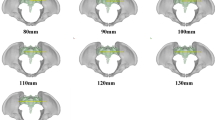Abstract
Objective
To provide the anatomical basis for the feasibility and clinical practice of lengthened sacroiliac screw fixation, by measuring various related indicators of the safe insertion regions of S1 and S2 lengthened sacroiliac screws.
Methods
A total of 66 healthy pelvises of adults were scanned by 64-slice spiral CT and the length, width and height of the safe insertion regions for S1 and S2 lengthened sacroiliac screw were measured. The safe screw entrance point locations were described with a quantitative method. The indicators were recorded by descriptive statistics and the statistics of left and right sides, segments of S1 and S2, and different layers (including top, middle and bottom parts) of S1 and S2 were compared.
Results
The lengths of ilium within the safe insertion regions for lengthened screws are more than 16 mm. The width and height of the safe insertion region of S1 and S2 are almost all more than 7.3 mm. Generally, the width and height of S1 are larger than those of S2. The reference ranges of the best/safest entrance point locations of lengthened sacroiliac screws are as follows—S1: 42.21–63.69 mm in front of posterior superior iliac spine, 32.77–53.75 mm above the highest point of the greater sciatic notch; S2: 22.68–54.28 mm in front of posterior superior iliac spine, 14.06–33.70 mm above the highest point of the greater sciatic notch.
Conclusion
(1) There is anatomical feasibility for the placements of S1 and S2 lengthened sacroiliac screws. (2) φ 7.3-mm partial thread cannulated screw (thread length 16 mm) and φ 6.5-mm partial thread cancellous screw(thread length 16 mm) can be used as lengthened sacroiliac lag screw. (3) The safe insertion space of S1 is larger than that of S2. (4) There is safe space for placement of at least one piece of lengthened sacroiliac screw in both S1 and S2. (5) The best/safest entrance points of S1 and S2 can be approximately located with anatomical landmarks.










Similar content being viewed by others
References
Beaule′ PE, Antoniades J, Matta JM (2006) Trans-sacral fixation for failed posterior fixation of the pelvic ring. Arch Orthop Trauma Surg 126:49–52
Conflitti JM, Graves ML, Chip Routt ML (2010) Radiographic quantification and analysis of dysmorphic upper sacral osseous anatomy and associated iliosacral screw insertions. J Orthop Trauma 24:630–636
Gardner MJ, Chip Routt ML (2011) Transiliac–transsacral screws for posterior pelvic stabilization. J Orthop Trauma 25:378–384
Duwelius PJ, Van Allen M, Bray TJ et al (1992) Computed tomography-guided fixation of unstable posterior pelvic ring disruptions. J Orthop Trauma 6(4):420–426
Matta JM, Saucedo T (1989) Internal fixation of pelvic ring fractures. Clin Orthop 242:83–97
Van Zwienen CM, Van den Bosch EW, Snijders CJ et al (2004) Biomechanical comparison of sacroiliac screw techniques for unstable pelvic ring fractures. J Orthop Trauma 18(9):589–595
Author information
Authors and Affiliations
Corresponding author
Rights and permissions
About this article
Cite this article
Zhao, Y., Li, J., Wang, D. et al. Parameters of lengthened sacroiliac screw fixation: a radiological anatomy study. Eur Spine J 21, 1807–1814 (2012). https://doi.org/10.1007/s00586-012-2367-z
Received:
Revised:
Accepted:
Published:
Issue Date:
DOI: https://doi.org/10.1007/s00586-012-2367-z




